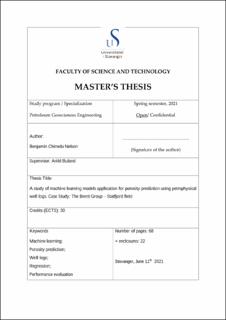| dc.description.abstract | The use of machine learning algorithms for predictive analytics is making a growing impact in the field of petroleum geosciences. With the increasing cost and time-related factors for obtaining accurate porosity measurements from well logging and coring operations, machine learning (ML) provides a more economical and efficient solution to this challenge.
In this thesis, various ML models are applied to predict porosity in a well penetrating the reservoir interval of the Brent Group to Top Cook formation. The study area is the Statfjord field, located in the Norwegian sector of the North Sea. Statfjord produces oil and associated gas from Jurassic sandstone in the Cook formation, Brent and Statfjord Group.
Sixteen wells with several well logs serve as input features to predict the porosity in a blind well 33/9-4, all located in the field. The machine learning input features are the well logs, feature engineered logs, location points and the measured depth. The logs include: caliper, resistivity, gamma-ray, sonic, density; the engineered logs include: acoustic impedance and facies; the location: x,y,z; and the well’s measured depth. The input features are varied and ingested into the ML models to estimate the porosity in the predefined reservoir interval.
The predicted porosity results for the blind well indicated an excellent performance demonstrated by the Bayesian ridge regression, linear regression and random forest models compared to the other ML models used in this study. These three algorithms are highly effective and accurate in predicting porosity with the limited range of the dataset and the results show they can be applied as a more general porosity estimation technique by varying the scale of the data samples and the number of wells. | |
